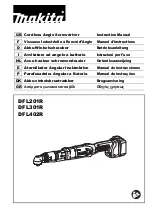
BOP-1K-GL 111315
3-23
When sending these commands via the GPIB, these commands require a query to be added to
the command string to verify the previous command is complete. When the command is com-
plete, the unit updates the status byte and indicates MAV (Message Available, bit 4 - see Table
A-3) is true. MAV indicates that there is a response to be received by the computer, so when it
becomes set, the unit is ready for its next command after reading back the data from the query
that was added to the command string.
When sending the above commands via the RS 232 bus, data flow control must be enabled
(XON) for the unit to properly update flash memory.
The *OPC? query is ideal to check if the previous command is complete since it returns either a
1 or 0. It is important that it be sent as a part of the same string as the command that causes a
flash update. As an example, sending CAL:SAVE 12/31/2005;:*opc? or *opc?;:CAL:SAVE
12/31/2005 are valid command strings. Sensing the commands separately will not verify that the
previous command is complete. Figure 3-6 is a program written in C, incorporating these tech-
niques.
Failure to provide an adequate delay can result in:
• Commands that are not processed,
• The following command may be received in error, causing an error in the transmission,
• Unit lock-up requiring power cycling of the unit. If working via the GPIB bus, sending
Interface Clear and Device Clear followed by *RST will unlock the unit.
3.5.6
STORING/RECALLING POWER SUPPLY OUTPUT SETTINGS
The power supply settings (mode, main channel reference type and setting, protection limit type
and setting and output status) can be stored in one of 99 memory locations for later recall. This
is accomplished using the *SAV command (see PAR A.12).
To recall parameters previously saved in one of the 99 locations send *RCL (see PAR A.10).
Once the *RCL command is issued, the stored settings are applied to the unit.
CAUTION: If you are not sure what the saved settings are, disconnect the load before
issuing *RCL. Then issue queries to identify the stored settings.
Locations 1 through 15 can be used to store settings for power-up. By setting the power-up
switches (see PAR. 3.3.2.2) the settings previously saved to a location between 1 and 15 can be
configured to be applied to the unit upon power-up. If this feature is to be used it is recom-
mended that the unit be tagged with the location and saved settings to avoid unexpected behav-
ior upon power-up.
Содержание BOP-GL 1KW
Страница 2: ......
Страница 10: ......
Страница 20: ...x BOP 1K 111315 FIGURE 1 1 HIGH POWER BOP GL SERIES POWER SUPPLY...
Страница 36: ...1 16 BOP 1K GL 111315 FIGURE 1 3 BOP OUTPUT CHARACTERISTICS...
Страница 38: ......
Страница 116: ......
Страница 128: ......
Страница 174: ......
















































